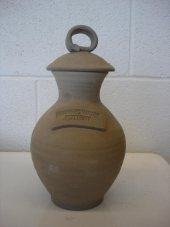Ollas are terracotta pots with narrow necks, that are dug into the ground BEFORE planting the particular crop with which you are using them. They are not cheap. I have spent 3 years collecting enough for my use. I have used gallon ollas in the center of the hill of squash and pumpkins. The first time I tried it with pumpkins, I got a 25 lb. Musque de Provence, which is the maximum size they grow! I was impressed. I have also used long narrow ones in 15 gal. pots with Potatoes and small round ones with small melons. If you get gallon or larger, they will work with tomatoes as well.
They are durable, but need to be dug up and stored for the winter in any place with frost. If you are careful with them -- don't drop them on concrete, bang them into each other, let water freeze in them or bang into them with a shovel or hoe -- they should last about 3,000 years. It's the sort of thing archaeologists dig up.
I like them, but sometimes I have placed them in inconvenient places and had a hard time getting them filled with water. Keep this in mind when you decide where to locate them in relation to the path in your garden. Also, you need to insert a stone of appropriate size and shape in the top of the olla to keep mosquitoes out. This stone must be removed each time you fill with water, so keep the location within easy reach. I learned the hard way.


